AMCHP’s Collection of Public Health Emergency Preparedness and Response Stories
Public health emergencies have and will continue to reveal the critical importance of planning for and responding to the needs of women, children, and families, including those with special health care needs. We can begin to understand the depth and complexity of those needs by first listening to individuals who have experienced the personal and professional impacts of emergencies, from fires and hurricanes to the COVID-19 pandemic. This collection aims to uplift the unique stories of those individuals in ways that can:
- Build the evidence base for policies and practices that support equity-centered emergency responses;
- Prompt meaningful action at all levels, including among Title V Maternal and Child Health (MCH) and related program staff within jurisdictional health agencies; and
- Ensure others with lived experience feel seen and consider sharing their stories.
How to Interact with This Resource
 |
1. Under “Explore the stories”, you will find a collection of stories featuring a video or written narrative (with optional audio component) that will each take no longer than 10-15 minutes to review. |
 |
2. Using the brief description, choose which stories you would like to explore further. Click on the hyperlink to “View this story” and a new page will open up select the stories you want to access. |
   |
3. Navigate through the individual contributor pages to access the story (either in written or video format). Each story includes accessibility features, such as text-to-speech, on-screen captions, and full transcripts. |
 |
4. View/download the one-page snapshot which briefly summarizes major takeaways for individuals and families, health and related systems, and communities. As you explore, consider your spheres of influences and how you can be a catalyst for moving from intention to action. |
 |
5. Share these stories with decision-makers, work them into tabletop exercises or other staff trainings, or use them to start a dialogue with colleagues from your jurisdiction’s Public Health Emergency Preparedness and Response (PHEP) program. |
Explore The Stories
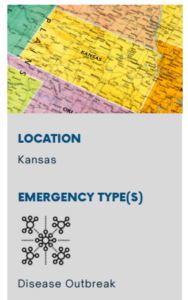 Cassandra Sines
Cassandra Sines
In this brief written narrative, a mother of children with special health care needs describes her family’s experience navigating uncertainty at the outset of and during the COVID-19 pandemic.
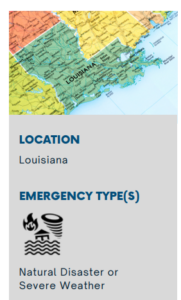 Louisiana Department of Health
Louisiana Department of Health
(Cheryl Harris, Jantz Malbrue, Ngoc Huynh)
In this brief written narrative, Louisiana Title V leaders discuss how Hurricane Ida (2021) impacted the state’s newborn screening program – including efforts to implement their continuity of operations plan with limited communication capacity and how they made modifications to address new challenges as they arose.
VIEW THE LOUISIANA DEPARTMENT OF HEALTH’S STORY
 Nicole LeBlanc
Nicole LeBlanc
In this series of video clips from a structured interview, an autistic woman describes the personal impact of both practical and mental health challenges arising from the COVID-19 pandemic. She provides specific recommendations to decision-makers at all levels of government for how to (more effectively) consider the needs of individuals with disabilities before, during, and after emergencies.
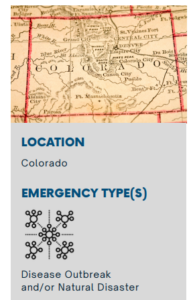 LaShay Canady
LaShay Canady
In this video, a public health professional shares details of her emergency preparedness plan to assure the safety of two family members who require full care. With the “red suitcase” packed and ready, she explains her strategy to support her family’s evacuation in less than 30 minutes with attention to detail regarding medications, wheelchair navigation, durable medical equipment, and nutrition supplies.
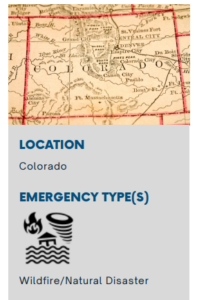 Micklina Kenyi
Micklina Kenyi
In this video, an immigrant from South Sudan shares the story of her family’s evacuation from a wildfire that wiped out entire neighborhoods in her suburb west of Denver. She shares her sense of panic as her historical trauma was triggered as she struggled to coordinate her family’s unforeseen evacuation.
 South Carolina Department of Health & Environmental Control
South Carolina Department of Health & Environmental Control
(Anna Bleasdale)
In this brief written narrative, the CYSHCN Director in South Carolina discusses the states sheltering process when responding to natural disasters, specifically hurricanes. Anna Bleasdale, who is also a registered nurse, also discusses the state’s use of the Nursing Triage Line and provides recommendations around communications and collaborations for other jurisdictions.
VIEW THE SOUTH CAROLINA DEPARTMENT OF HEALTH & ENVIRONMENTAL CONTROL’S STORY
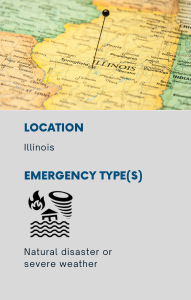 Molly Hofmann, Stephanie Leach, Courtney Kerfoot, Susan Agrawal, & Pam Winsel
Molly Hofmann, Stephanie Leach, Courtney Kerfoot, Susan Agrawal, & Pam Winsel
In this MCH Bridges podcast episode, leaders from the University of Illinois Chicago’s Division of Specialized Care for Children (DSCC), The Arc of Illinois, and Illinois Healthcare and Family Services (Medicaid agency) describe and reflect in detail on their experience approving and ultimately implementing an amendment for the Medically Fragile Technology Dependent Waiver that enabled backup generators to be purchased with service funds.
VIEW MOLLY HOFMANN, STEPHANIE LEACH, COURTNEY KERFOOT, SUSAN AGRAWAL, & PAM WINSEL’S STORY
Have a story you’d like to share? Send an e-mail to PHEP@amchp.org, and a member of our project team will reach out to you about the contribution process.
Additional Information and Resources
The list below is by no means an exhaustive one but includes resources that complement and build upon this collection of stories.
- Online resource – Public Health Emergency Preparedness and Response Checklist for Maternal and Infant Health
Author(s): AMCHP, Centers for Disease Control and Prevention (CDC) Division of Reproductive Health
Author(s): Assistant Secretary for Preparedness and Response (ASPR), U.S. Department of Health and Human Services
Author(s): Council of State and Territorial Epidemiologists (CSTE)
Author(s): Centers for Disease Control and Prevention (CDC) Division of Nutrition, Physical Activity, and Obesity
- Training Course – Prepared4ALL: Whole Community Inclusive Emergency Planning
Author(s): Association of University Centers on Disabilities (AUCD)
Is there a related resource you’d like to see included in the list above? E-mail your recommendation to: workforce@amchp.org.
Funding Acknowledgment
This project is supported by the Centers for Disease Control and Prevention (CDC) of the U.S. Department of Health and Human Services (HHS) under grant number 5 NU38OT000296-05-00, a cooperative agreement with the Center for State, Tribal, Local, and Territorial Supports (CSTLTS) entitled IMPACTS for MCH: Improving Performance and Capacity in Territories & States for Maternal & Child Health, with 100 percent funded by CDC/HHS. The contents are those of the author(s) and do not necessarily represent the official views of, nor an endorsement, by CDC/HHS, or the U.S. Government. This information, content, and conclusions are those of the author and should not be construed as the official position or policy of, nor should any endorsements be inferred by CDC, HHS, or the U.S. Government.
